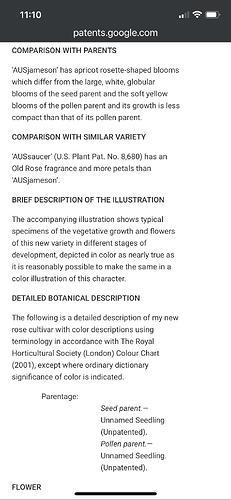Yes, you definitely don’t need it to be an Austin. But I wouldn’t avoid austins, per se. I’m only familiar with their more recent work to be fair, but many of them could be a good starting point in my opinion. I am aware the pool of Austins I’m working with is pretty limited, with the oldest of the bunch being Lady Emma Hamilton (2005), but many of them are pretty healthy in my garden and the flower form in the recent hybrids tend to be much more refined than with Tantau’s and Kordes’ quartered varieties (with due exceptions). The main incompatibility is that Austin seems to be increasingly selecting for self-cleaning varieties.
Tantau’s Artemis is very healthy in my experience (mostly blackspot, I can’t talk for mildew unless the variety is very susceptible). It works as a seed parent, but the only color I seem to get from it is white. None of its seedlings made it past the first year for me (I didn’t grow that many though) as they all looked like the mother, but a bit less refined.
I used Tantau’s Soul as a pollen parent last year for the first time. Good variety, huge deep red flowers and good scent. It gets big though, and it is not as healthy as Tantau marketed it (“completely immune from fungal problems”), but still very good blackspot resistance.
I know Kordes’ Markenzauber sets hips and could be a good parent. I don’t know how it germinates though, and the quality of the seedlings.
PhenoGeno also has a few interesting hybrids, but I don’t know if they’re available where you are.
I’m not sure I agree with this, Paul. The lack of a breeding record may be due to several factors, not only due to the lack of quality of the seedlings. This is most likely the case for these varieties, but there are many more from more recent year that do produce seedlings worth growing. I would specifically consider that for the past 25 years Austin hasn’t disclosed the parentage of his hybrids, and many of his variety may well have descendants in commerce we don’t know of.
As I said, The Wedgwood Rose is one of my favorite seed parents. It allows for good color saturation at least in the pink department. It can produce apricot seedlings, but I have no experience with it. When mated with the right thing, its offspring can have some of the best scents in the seedling bed. The main things to select for are (in my opinion) reduced size and stronger canes. I have a very pretty TWR x Munstead Wood hybrid that produces cerise rosettes with a strong old rose/lily of the valley scent, and has an extremely interesting holly-like foliage; it seems to be more compact than TWR, but it also seems to be suscepible to powdery mildew.
I’ve only grown a batch of OP Roald Dahl seeds last year. Many of them were weak, but I registered my record germination rate (except for very small non statistically significant batches) at about 71%. It seems to throw yellows fairly easily; it probably needs careful matching to avoid cracking its disease resistance.
Munstead Wood has abundant pollen and matched with the right thing could produce something very beautiful. I had a decent germination rate on its self-set seeds but they were too weak and sickly. The intentional crosses I had with it seem to be way healthier and stronger.
Desdemona seems to be a good seed parent. I have a very healthy and vigorous OP seedlings from last year that seems to be a climber. Very healthy variety and very good scent. Excellent rebloom too.
Lady Emma Hamilton can be a good parent and has good horizontal BS resistance in my experience; one of the best scents around, too. Sets seeds fairly easily and they do germinate. I’m seeing my first germinations on a LEH*Pink Double Knock Out cross I have high hopes for.
I know people routinely get HT types from James Galway as a seed parent, but I have no experience with it. I also know people use Wollerton Old Hall and Claire Austin, but I’ve no experience with them.
I’m really looking forward to trying to breed with Silas Marner next spring as it seems to be extremely interesting.
